Dynamic Compressive Mechanical Property Characteristics and Fractal Dimension Applications of Coal-Bearing Mudstone at Real-Time Temperatures
Abstract
:1. Introduction
2. Characterization and Test Methods for Coal-Bearing Mudstone
2.1. Real-Time Temperature SHPB Testing Method and Process
- The tests are conducted using a high-to-low temperature gradient approach, with each rock sample pressure gradient tested at a particular temperature gradient before moving to the next one. The mudstone obtained from coal-bearing strata is placed in an external heating oven and subjected to a predetermined temperature for 10 min in a high-temperature ambient oven. The sample is then placed between the incoming and transmitting bars using a fire clamp to ensure that the temperature difference between the displayed real-time temperature and the preset temperature is within ±1 °C.
- The air pressure score should be adjusted before swiftly holding the mudstone rock sample in place with the incidence and transmission bars for impact testing. During this process, it is essential to record the impact bullet velocity and strain signals in the incidence and transmission bars.
- After the test, the incident and transmission bars are promptly extracted from the high-temperature ambient furnace. The rock samples are then retrieved using an iron spoon and transferred into an iron container. The container is subsequently placed inside an externally heated furnace with an appropriate temperature gradient to ensure that the samples remain intact and undamaged during the high-temperature ambient cooling process.
- Once the impact tests for all rock samples at a particular temperature gradient are complete, the fragments are gradually cooled to room temperature within an externally heated furnace with a temperature reduction gradient. The samples are then ready for the next round of impact tests at a different temperature gradient. For instance, if the preset temperature is 400 °C, the initial holding time is 30 min at 400 °C, followed by a temperature reduction of 50 °C at a rate of 10 °C/min, along with an additional 60-min holding time at the gradient. Finally, the temperature is further reduced until it reaches room temperature (25 °C), as demonstrated in Figure 3c.
- Upon completion of impact testing across all temperature gradients, the macroscopic damage characteristics and microscopic fracture patterns of the fractured rock samples are analyzed and quantified.
2.2. Test Principle and Accuracy Verification
3. Dynamic Compressive Mechanical Properties of Coal-Bearing Mudstone
3.1. Variation of Strain Rate with Air Pressure
3.2. The Variation Law of the Stress–Strain Curve
3.3. The Change in Dynamic Compression Mechanical Properties
3.4. Variation of Dynamic Mechanical Properties with Temperature
4. Fractal Failure Characteristics of Coal-Bearing Mudstone
4.1. Macroscopic Damage Characteristics
4.2. Blockiness Distribution Coefficient
4.3. Fractal Dimension of Fragments
5. Discussion
5.1. Different Stages of Real-Time Temperature Influence
5.2. Correlation of Fractal Dimensions and Applications
6. Conclusions
- Peak stress and elastic modulus exhibit an initially increasing and then decreasing trend with rising temperature. They demonstrate a slight increase between 25 and 150 °C, followed by a monotonous decreasing trend between 150 and 400 °C. The blockiness distribution coefficient exhibits an initially increasing and then decreasing trend, while the fractal dimension shows an initially decreasing and then increasing trend as the temperature rises. Combined with macroscopic damage morphology, it indicates an initial decrease and subsequent increase in the extent of damage to the coal-bearing mudstone with increasing temperature.
- The influence of real-time temperature on coal-bearing mudstone can be classified into two stages. The correlation coefficients between the fractal dimension of the fragments and the peak stress, elastic modulus, and peak strain are −0.944, −0.916, and −0.460, respectively. Peak stress and elastic modulus decrease linearly with the increase in the fractal dimension.
Author Contributions
Funding
Data Availability Statement
Conflicts of Interest
References
- Su, F.; Nakanowataru, T.; Itakura, K.I.; Ohga, K.; Deguchi, G. Evaluation of Structural Changes in the Coal Specimen Heating Process and UCG Model Experiments for Developing Efficient UCG Systems. Energies 2013, 6, 2386–2406. [Google Scholar] [CrossRef]
- Nourozieh, H.; Kariznovi, M.; Chen, Z.; Abedi, J. Simulation Study of Underground Coal Gasification in Alberta Reservoirs: Geological Structure and Process Modeling. Energy Fuels 2010, 24, 3540–3550. [Google Scholar] [CrossRef]
- Jia, B.; Xian, C.G.; Tsau, J.S.; Zuo, X.; Jia, W.F. Status and Outlook of Oil Field Chemistry-Assisted Analysis during the Energy Transition Period. Energy Fuels 2022, 36, 12917–12945. [Google Scholar] [CrossRef]
- Jia, B.; Xian, C.G. Permeability Measurement of the Fracture-matrix System with 3D Embedded Discrete Fracture model. Pet. Sci. 2022, 19, 1757–1765. [Google Scholar] [CrossRef]
- Corkum, A.G.; Martin, C.D. The Mechanical Behavior of Weak Mudstone (Opalinus Clay) at Low Stresses. Int. J. Rock Mech. Min. Sci. 2007, 44, 196–209. [Google Scholar] [CrossRef]
- Taheri, A.; Tani, K. Use of Down-hole Triaxial Apparatus to Estimate the Mechanical Properties of Heterogeneous Mudstone. Int. J. Rock Mech. Min. Sci. 2008, 45, 1390–1402. [Google Scholar] [CrossRef]
- Douma, L.A.N.R.; Primarini, M.I.W.; Houben, M.E.; Barnhoorn, A. The Validity of Generic Trends on Multiple Scales in Rock-physical and Rock-mechanical Properties of the Whitby Mudstone, United Kingdom. Mar. Pet. Geol. 2017, 84, 135–147. [Google Scholar] [CrossRef]
- Lei, X.L.; Nishizawa, O.; Kusunose, K.; Cho, A.; Satoh, T. Compressive Failure of Mudstone Samples Containing Quartz Veins Using Rapid AE Monitoring: The Role of Asperities. Tectonophysics 2000, 328, 329–340. [Google Scholar] [CrossRef]
- Ji’an, L.; Wang, L. High-Temperature Mechanical Properties of Mudstone in the Process of Underground Coal Gasification. Rock Mech. Rock Eng. 2011, 44, 749–754. [Google Scholar]
- Zhao, F.; Shi, Z.; Sun, Q. Fracture Mechanics Behavior of Jointed Granite Exposed to High Temperatures. Rock Mech. Rock Eng. 2021, 54, 2183–2196. [Google Scholar] [CrossRef]
- Zhu, Z.N.; Tian, H.; Jiang, G.S.; Cheng, W. Effects of High Temperature on the Mechanical Properties of Chinese Marble. Rock Mech. Rock Eng. 2018, 51, 1937–1942. [Google Scholar] [CrossRef]
- Kong, B.; Wang, E.; Li, Z.; Wang, X.; Liu, J.; Li, N. Fracture Mechanical Behavior of Sandstone Subjected to High-Temperature Treatment and Its Acoustic Emission Characteristics Under Uniaxial Compression Conditions. Rock Mech. Rock Eng. 2016, 49, 4911–4918. [Google Scholar] [CrossRef]
- Liu, X.; Zhang, C.; Yuan, S.; Fityus, S.; Sloan, S.W.; Buzzi, O. Effect of High Temperature on Mineralogy, Microstructure, Shear Stiffness and Tensile Strength of Two Australian Mudstones. Rock Mech. Rock Eng. 2016, 49, 3513–3524. [Google Scholar] [CrossRef]
- Chen, J.; Yin, L.; Ren, S.; Lin, L.; Fang, J. The Thermal Damage Properties of Mudstone, Gypsum and Rock Salt from Yingcheng, Hubei, China. Minerals 2015, 5, 104–116. [Google Scholar] [CrossRef]
- Tang, F.; Wang, L.; Lu, Y.; Yang, X. Thermophysical Properties of Coal Measure Strata under High Temperature. Environ. Earth Sci. 2015, 73, 6009–6018. [Google Scholar] [CrossRef]
- Zhang, L.; Mao, X.; Li, M.; Li, B.; Liu, R.; Lu, A. Brittle–Ductile Transition of Mudstone in Coal Measure Rock Strata under High Temperature. Int. J. Geomech. 2020, 20, 04019149. [Google Scholar] [CrossRef]
- Zhang, L.; Ma, C.; Zhang, Z.; Li, B.; Lei, L. Experimental Research of Loading Rate Effect on Brittle-ductile Transition of Mudstone under High Temperature. Therm. Sci. 2019, 23, 959–965. [Google Scholar] [CrossRef]
- Lu, Y.; Wang, L.; Sun, X.; Wang, J. Experimental Study of the Influence of Water and Temperature on the Mechanical Behavior of Mudstone and Sandstone. Bull. Eng. Geol. Environ. 2017, 76, 645–660. [Google Scholar] [CrossRef]
- Wu, Z.; Qin, B.D.; Chen, L.J.; Luo, Y.J. Experimental Study on Mechanical Character of Sandstone of the Upper Plank of Coal Bed under High Temperature. Chin. J. Rock Mech. Eng. 2005, 24, 1863–1867. [Google Scholar] [CrossRef]
- Zhang, L.; Mao, X.; Liu, R.; Guo, X.; Ma, D. The Mechanical Properties of Mudstone at High Temperatures: An Experimental Study. Rock Mech. Rock Eng. 2014, 47, 1479–1484. [Google Scholar] [CrossRef]
- Zhang, L.; Mao, X.; Li, M.; Liu, R. Experimental Study of Thermal Expansion Characteristics of Coaly Mudstone at High Temperatures. Geotech. Geol. Eng. 2018, 36, 521–529. [Google Scholar] [CrossRef]
- Qin, Y.; Tian, H.; Xu, N.X.; Chen, Y. Physical and Mechanical Properties of Granite After High-Temperature Treatment. Rock Mech. Rock Eng. 2020, 53, 305–322. [Google Scholar] [CrossRef]
- Xiao, Y.; Lu, J.H.; Wang, C.P.; Deng, J. Experimental Study of High-Temperature Fracture Propagation in Anthracite and Destruction of Mudstone from Coalfield Using High-Resolution Microfocus X-ray Computed Tomography. Rock Mech. Rock Eng. 2016, 49, 3723–3734. [Google Scholar] [CrossRef]
- Shengyin, L.; Bin, D.; Hong, T.; Jie, C.; Peng, X.; Shitao, Z. Comparative Experimental Study on Physical and Mechanical Properties of Granite after Natural Cooling and under Real-time High Temperature. Earth Sci. Front. 2020, 27, 178–184. (In Chinese) [Google Scholar]
- Zhou, Z.; Li, X.; Ye, Z.; Liu, K. Obtaining Constitutive Relationship for Rate-Dependent Rock in SHPB Tests. Rock Mech. Rock Eng. 2010, 43, 697–706. [Google Scholar] [CrossRef]
- Zou, C.; Wong, L.N.Y. Size and Geometry Effects on the Mechanical Properties of Carrara Marble Under Dynamic Loadings. Rock Mech. Rock Eng. 2016, 49, 1695–1708. [Google Scholar] [CrossRef]
- Chen, Y.; Lu, A.; Mao, X.; Li, M.; Zhang, L. Nonlinear Dynamics Mechanism of Rock Burst Induced by the Instability of the Layer-Crack Plate Structure in the Coal Wall in Deep Coal Mining. Shock. Vib. 2017, 2017, 4051967. [Google Scholar] [CrossRef]
- Hao, Y.; Hao, H. Numerical Investigation of the Dynamic Compressive Behaviour of Rock Materials at High Strain Rate. Rock Mech. Rock Eng. 2013, 46, 373–388. [Google Scholar] [CrossRef]
- Li, C.; Xu, Y.; Chen, P.; Li, H.; Lou, P. Dynamic Mechanical Properties and Fragment Fractal Characteristics of Fractured Coal–Rock-Like Combined Bodies in Split Hopkinson Pressure Bar Tests. Nat. Resour. Res. 2020, 29, 3179–3195. [Google Scholar] [CrossRef]
- Wu, H.; Dai, B.; Cheng, L.; Lu, R.; Zhao, G.; Liang, W. Experimental Study of Dynamic Mechanical Response and Energy Dissipation of Rock Having a Circular Opening Under Impact Loading. Min. Metall. Explor. 2021, 38, 1111–1124. [Google Scholar] [CrossRef]
- Wu, J.; Jing, H.; Gao, Y.; Meng, Q.; Yin, Q.; Du, Y. Effects of Carbon Nanotube Dosage and Aggregate Size Distribution on Mechanical Property and Microstructure of Cemented Rockfill. Cem. Concr. Compos. 2022, 127, 104408. [Google Scholar] [CrossRef]
- Wu, J.; Wong, H.S.; Yin, Q.; Ma, D. Effects of Aggregate Strength and Mass Fraction on Mesoscopic Fracture Characteristics of Cemented Rockfill from Gangue as Recycled Aggregate. Compos. Struct. 2023, 311, 116851. [Google Scholar] [CrossRef]
- Guo, L.; Wang, Y. Experimental Study on Energy Dissipation of Saturated Mudstone in Coal Mine under Impact Loading. Geofluids 2022, 2022, 5045961. [Google Scholar] [CrossRef]
- Kao, S.; Zhao, G.; Meng, X.; Li, Y.; Liu, Z.; Zhang, R.; Huang, S. Dynamic Mechanical Characteristics of Fractured Rock Reinforced by Different Grouts. Adv. Civ. Eng. 2021, 2021, 8897537. [Google Scholar] [CrossRef]
- Meng, L.; Han, L.; Zhu, H. Influence of Moisture Content on the Structural Characteristics of Argillaceous Weakly Consolidated Rock Caused by Dynamic Loading in the Coal Mine. Shock. Vib. 2021, 2021, 7206801. [Google Scholar] [CrossRef]
- Liu, W.; Yang, K.; Dou, L.; Wei, Z.; Chi, X.; Xu, R. Mechanical Properties and Failure Modes of CRCB Specimen under Impact Loading. Sci. Rep. 2022, 12, 12108. [Google Scholar] [CrossRef] [PubMed]
- Zhou, J.; Xu, W.; Zhao, G.; Meng, X.; Li, Y.; Wu, X.; Cheng, X. Energy Evolution Law and Fractal Characteristics of Different Rock Specimen Sizes on Dynamic Compression. Geofluids 2022, 2022, 5339603. [Google Scholar] [CrossRef]
- Hao, Y.; Hao, H. Finite Element Modelling of Mesoscale Concrete Material in Dynamic Splitting Test. Adv. Struct. Eng. 2016, 19, 1027–1039. [Google Scholar] [CrossRef]
- Liu, S.; Xu, J.Y. Fractal Analysis for Dynamic Failure Characteristics of Granite Induced by Mechanical–thermal Loading. Géotech. Lett. 2015, 5, 191–197. [Google Scholar] [CrossRef]
- Zhou, R.; Cheng, H.; Cai, H.; Wang, X.; Guo, L.; Huang, X. Dynamic Characteristics and Damage Constitutive Model of Mudstone under Impact Loading. Materials 2022, 15, 1128. [Google Scholar] [CrossRef]
- An, H.; Zeng, T.; Zhang, Z.; Liu, L. Experimental Study of the Rock Mechanism under Coupled High Temperatures and Dynamic Loads. Adv. Civ. Eng. 2020, 2020, 8866621. [Google Scholar] [CrossRef]
- Zhang, R.R.; Jing, L.W. Analysis on the Fragment and Energy Dissipation of Deep Sandstone after High/low Temperature Treatment in SHPB Tests. J. China Coal Soc. 2018, 43, 1884–1892. [Google Scholar]
- Wei, T.; Cheng, L.P.; Zhao, K.J. Application of Kernel Principal Component and Pearson Correlation Coefficient in Prediction of Mine Pressure Failure. In Proceedings of the 2017 Chinese Automation Congress (CAC), Jinan, China, 20–22 October 2017. [Google Scholar]


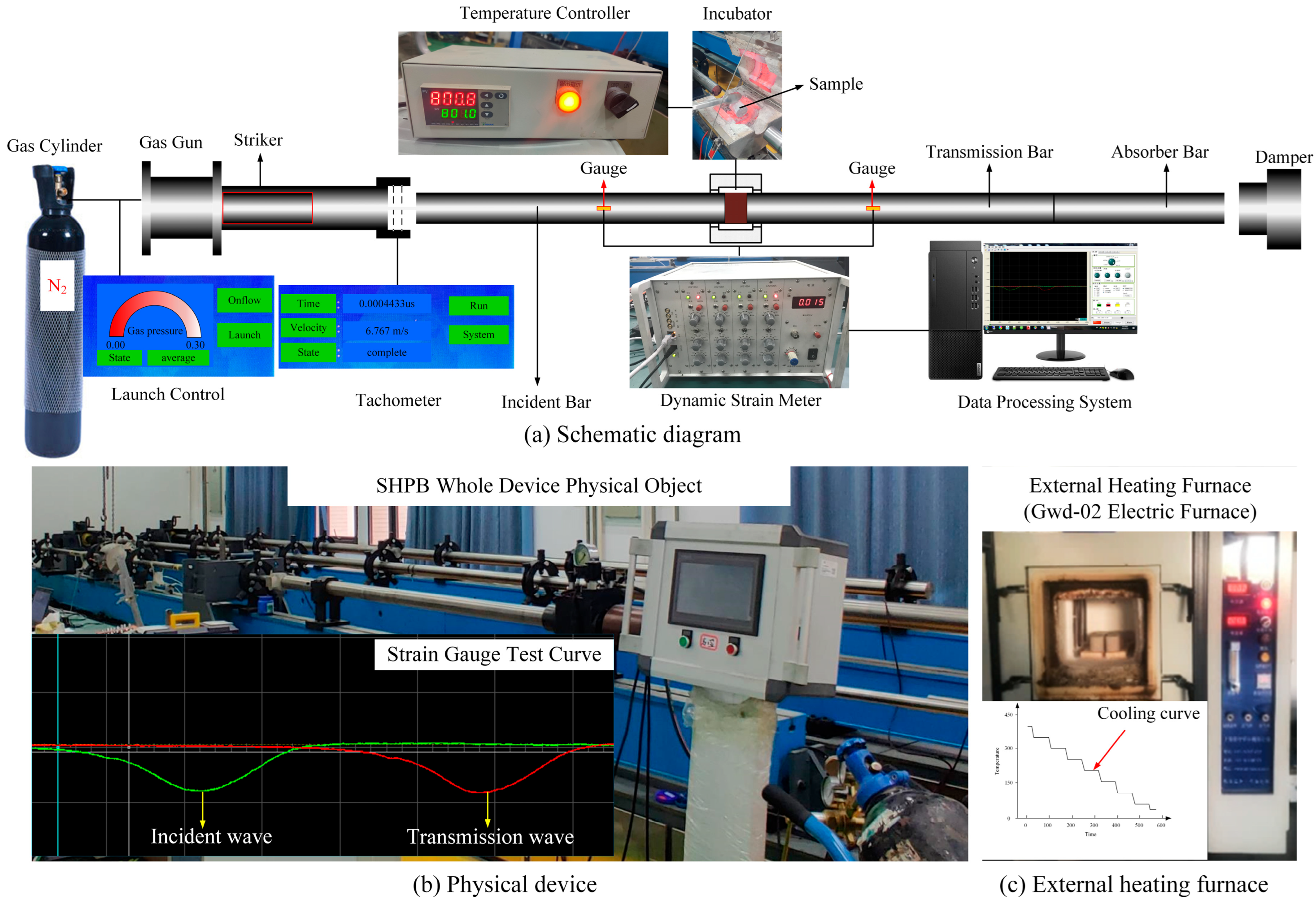
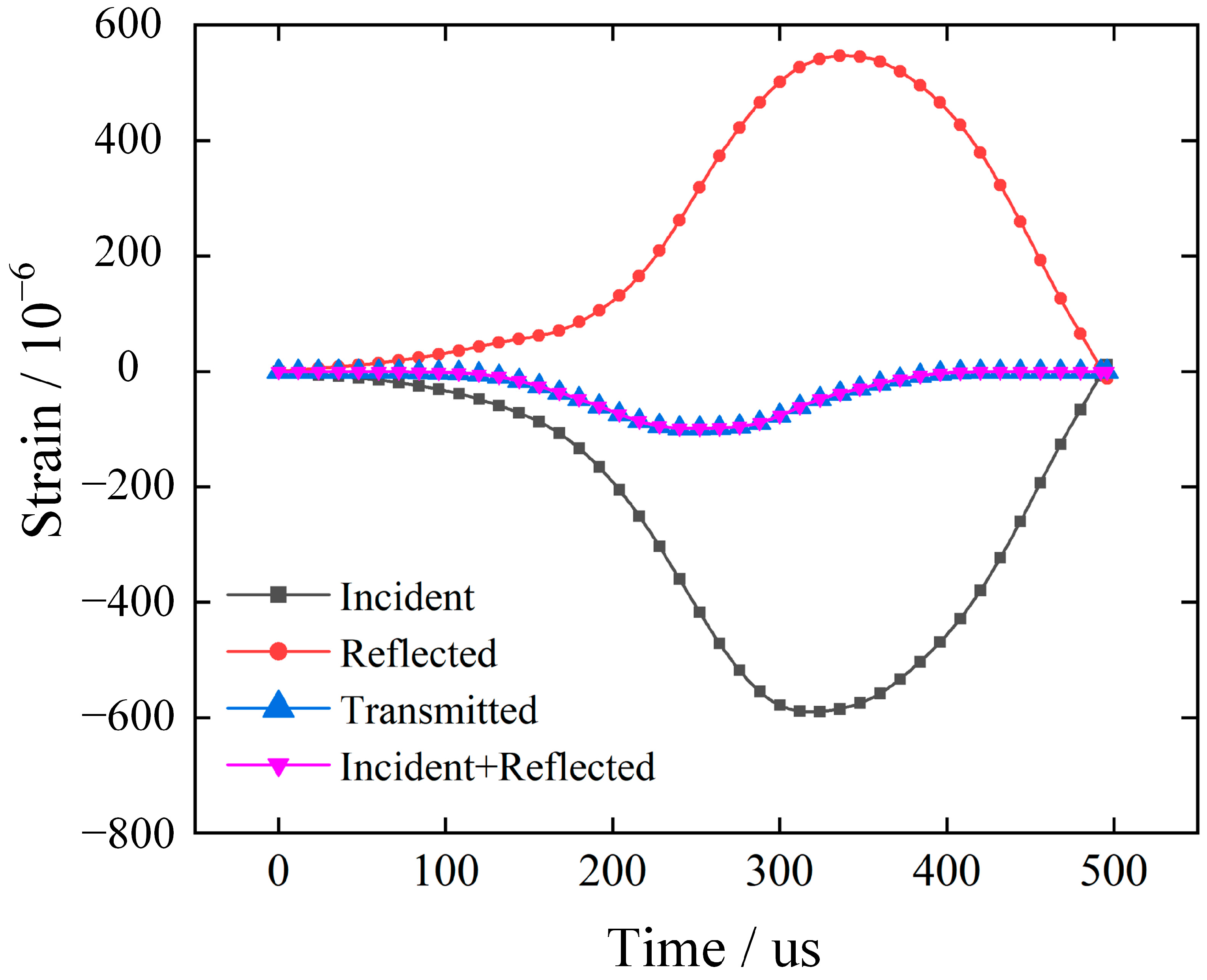

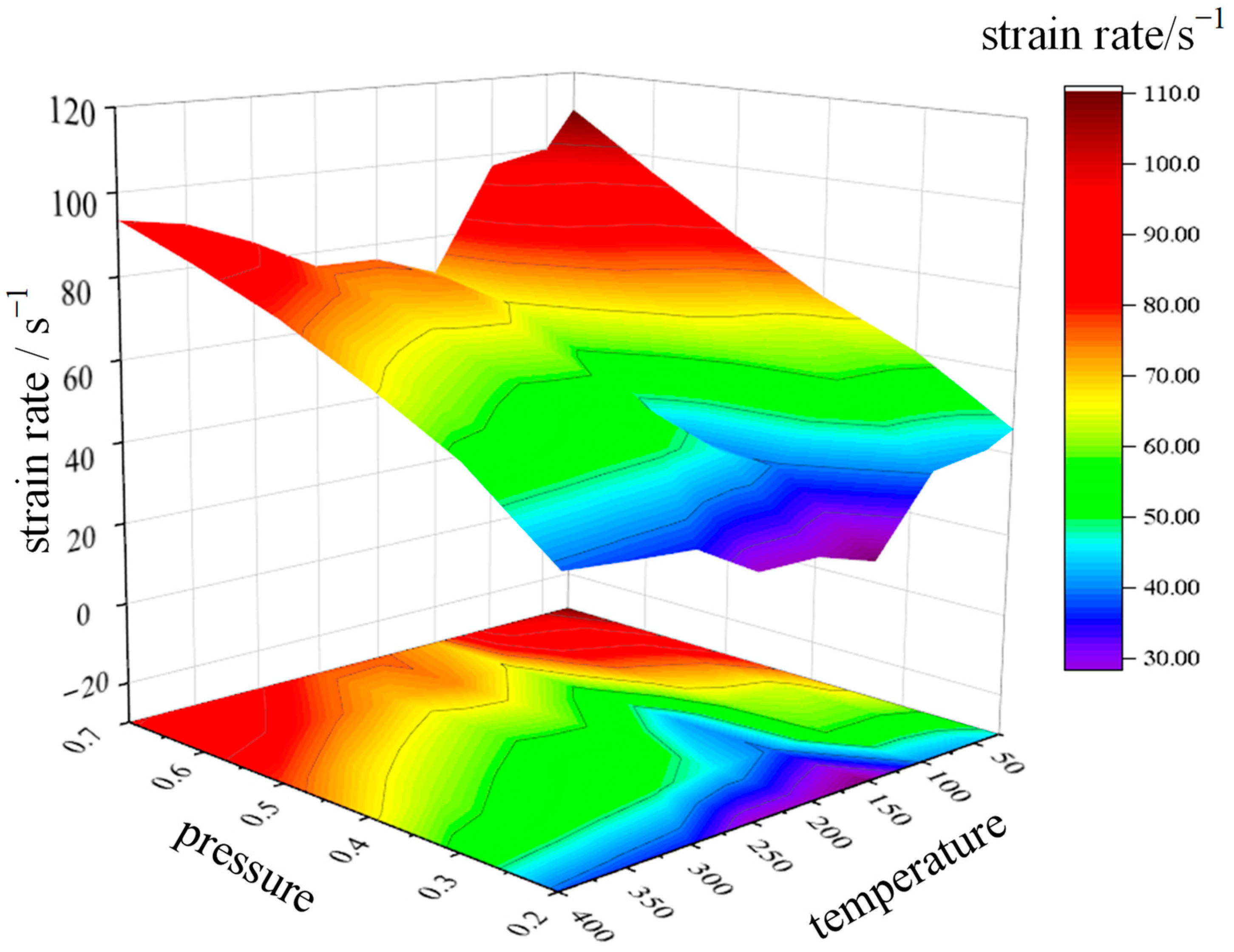




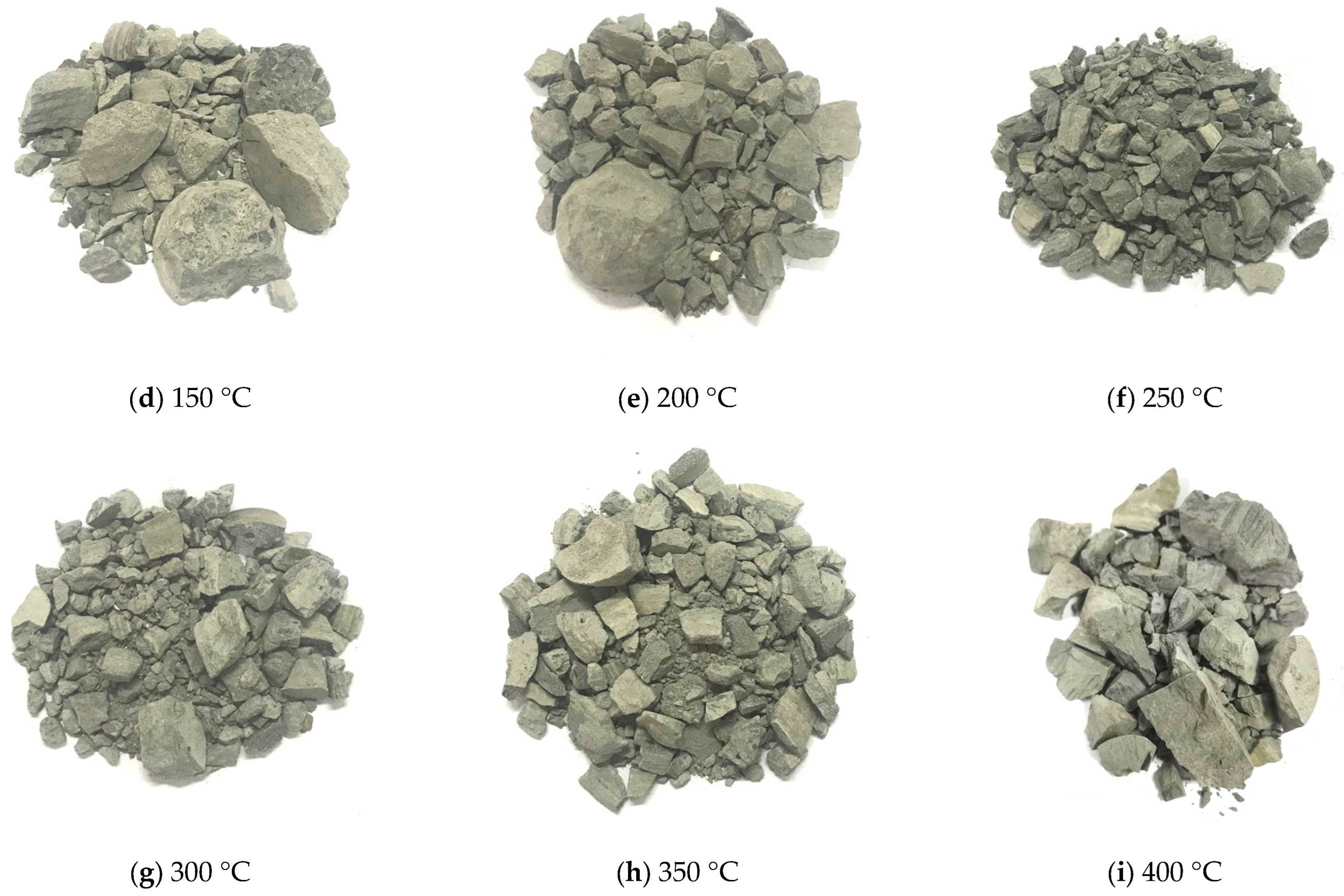
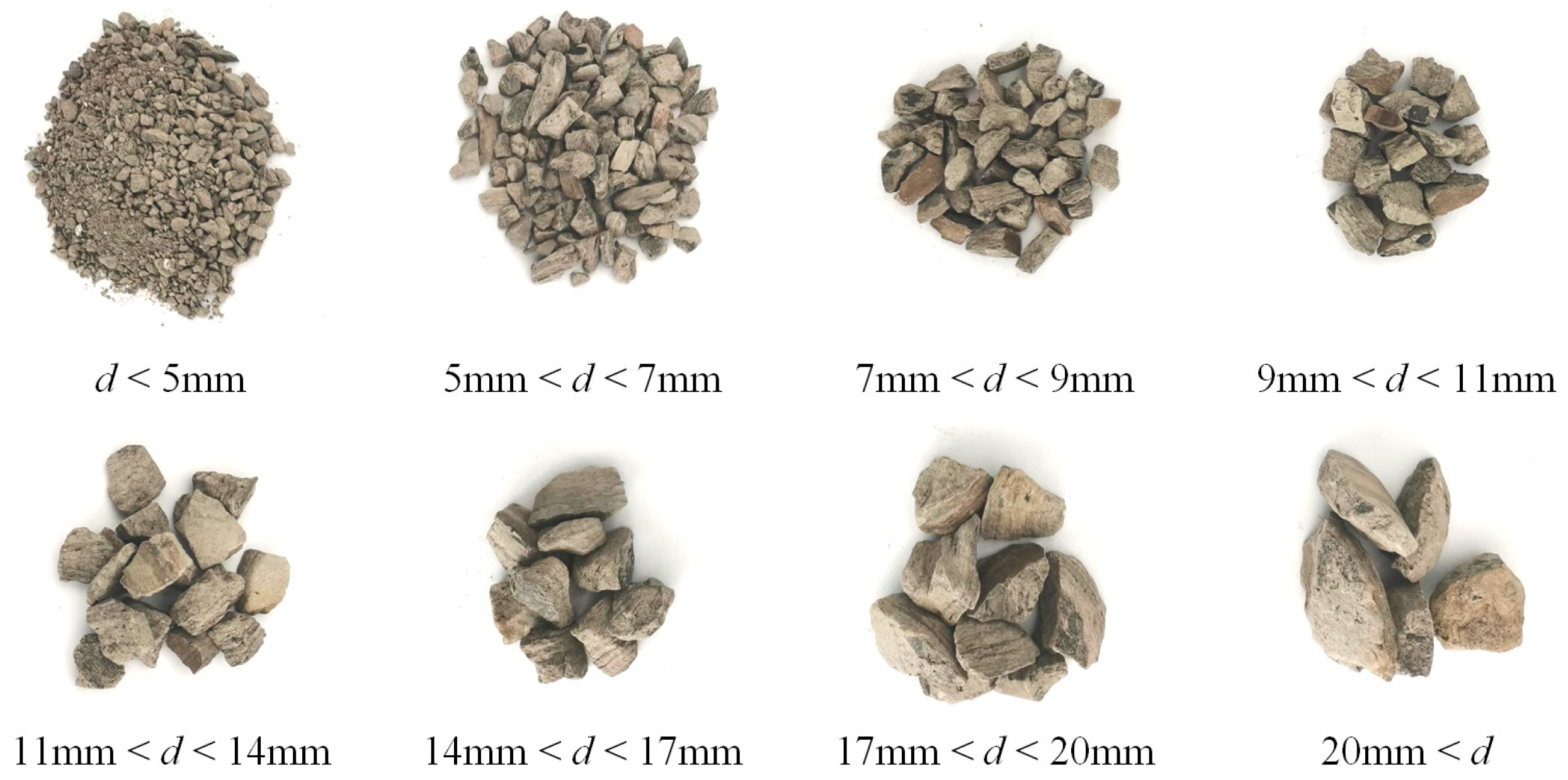
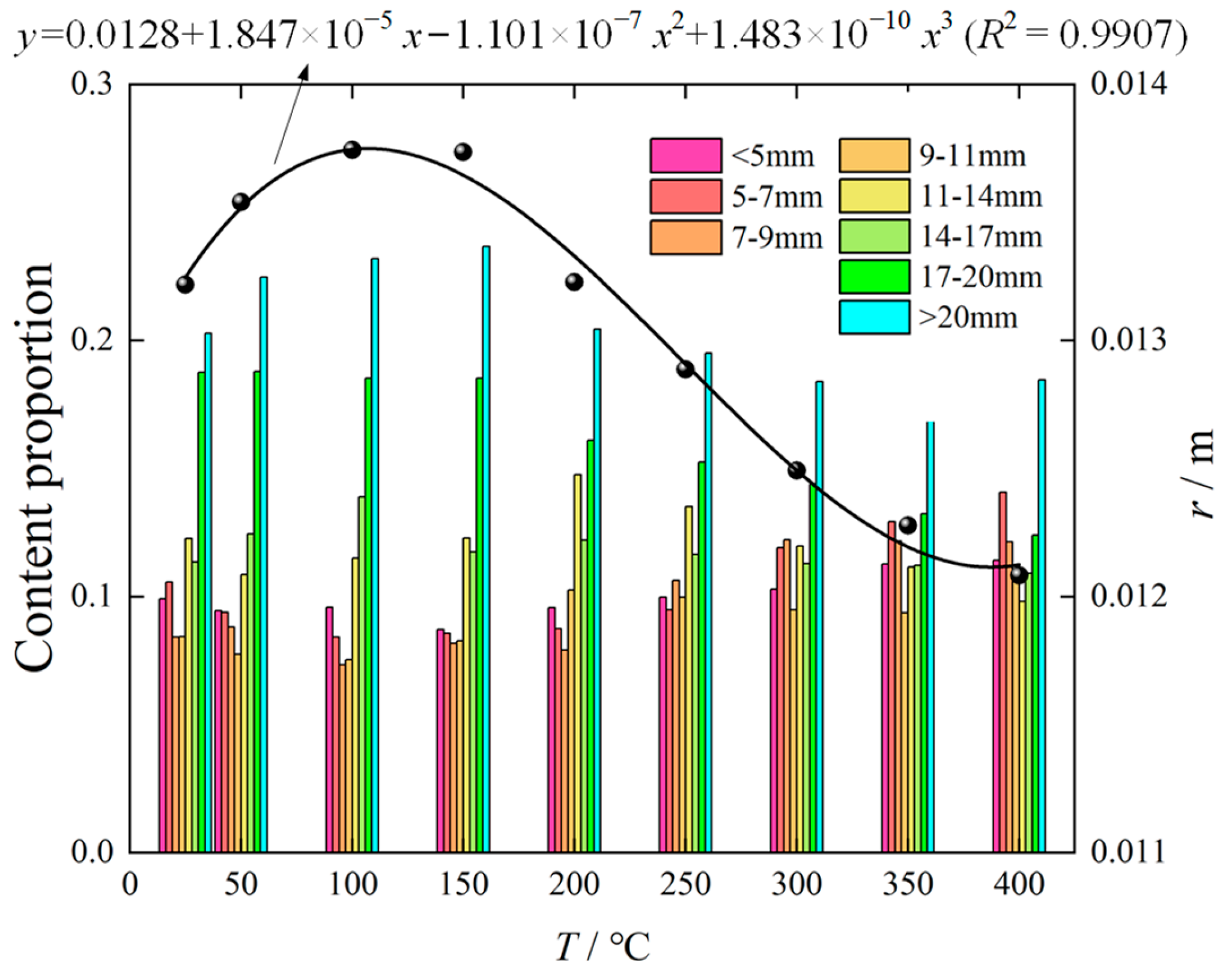
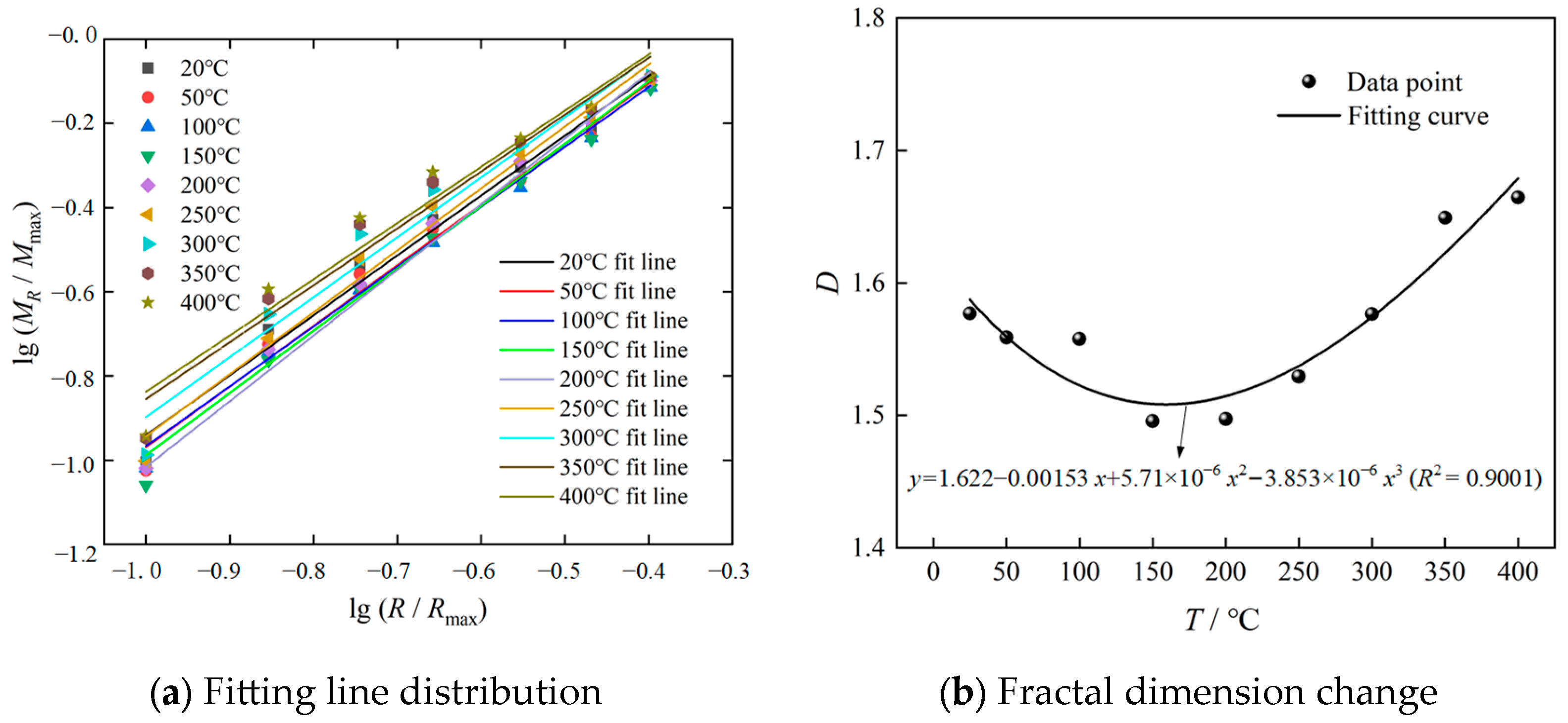

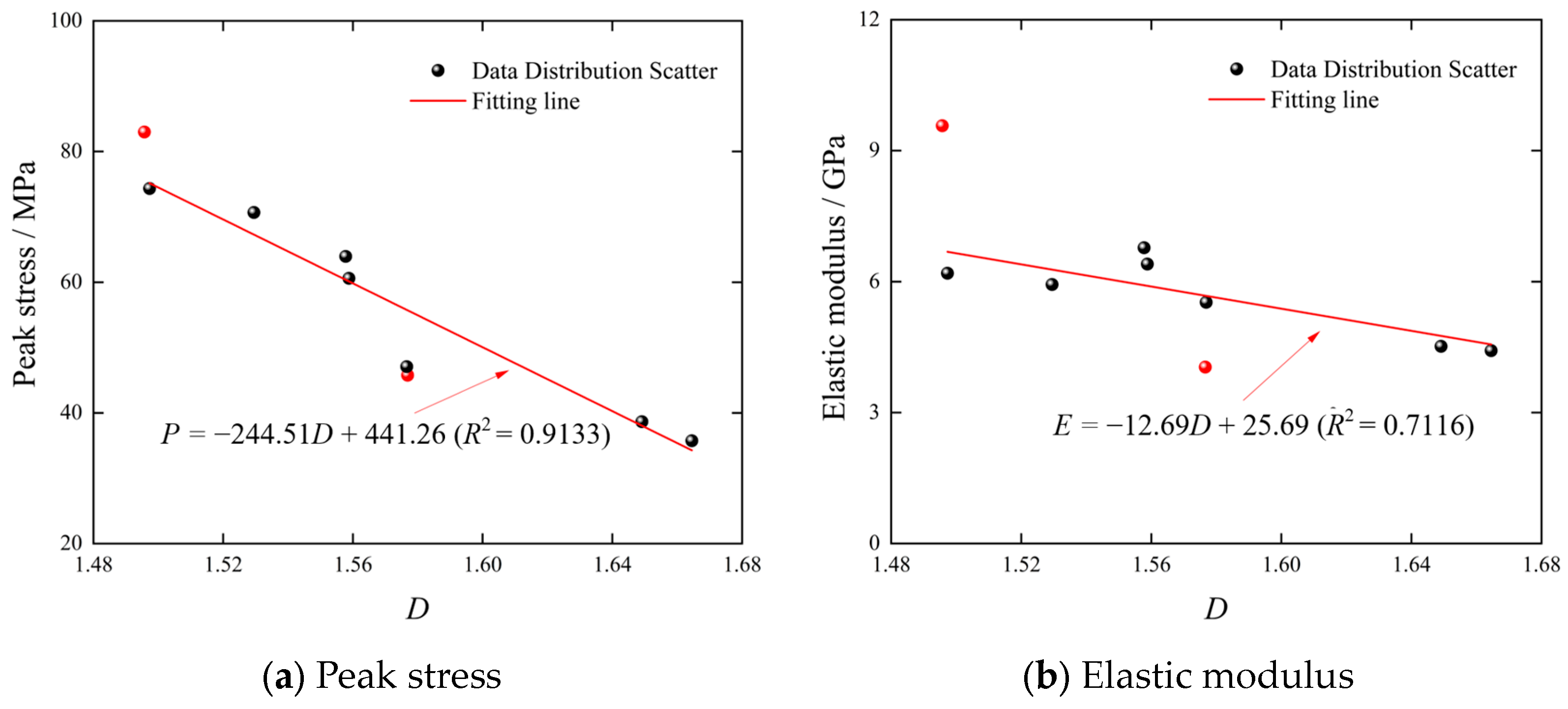
| Pressure/ Temperature | Strain Rate (s−1) | ||||||||
|---|---|---|---|---|---|---|---|---|---|
| 25 °C | 50 °C | 100 °C | 150 °C | 200 °C | 250 °C | 300 °C | 350 °C | 400 °C | |
| 0.2 MPa | 46.021 | 42.468 | 40.455 | 22.484 | 27.065 | 27.255 | 35.896 | 37.051 | 38.498 |
| 0.3 MPa | 60.650 | 58.035 | 57.765 | 39.164 | 45.895 | 50.053 | 51.651 | 53.849 | 55.819 |
| 0.4 MPa | 70.325 | 63.654 | 60.745 | 42.065 | 54.210 | 53.516 | 57.051 | 61.251 | 67.416 |
| 0.5 MPa | 82.551 | 75.721 | 70.545 | 54.898 | 62.516 | 61.048 | 65.055 | 70.027 | 77.874 |
| 0.6 MPa | 95.874 | 87.451 | 83.151 | 65.564 | 73.846 | 70.511 | 75.842 | 83.415 | 86.135 |
| 0.7 MPa | 110.052 | 100.165 | 97.105 | 70.712 | 76.154 | 76.447 | 84.515 | 90.754 | 93.464 |
| Pressure/ Temperature | Peak Stress (MPa) | ||||||||
|---|---|---|---|---|---|---|---|---|---|
| 25 °C | 50 °C | 100 °C | 150 °C | 200 °C | 250 °C | 300 °C | 350 °C | 400 °C | |
| 0.2 MPa | 45.779 | 38.323 | 49.621 | 43.021 | 42.275 | 43.330 | 26.227 | 25.756 | 28.223 |
| 0.3 MPa | 57.709 | 60.610 | 63.945 | 64.342 | 63.279 | 50.406 | 34.617 | 38.652 | 35.731 |
| 0.4 MPa | 71.488 | 86.077 | 77.874 | 73.899 | 74.356 | 70.675 | 47.080 | 47.114 | 41.711 |
| 0.5 MPa | 89.401 | 93.601 | 89.108 | 83.001 | 84.442 | 78.231 | 54.728 | 53.970 | 43.584 |
| 0.6 MPa | 94.921 | 99.370 | 97.283 | 95.828 | 98.811 | 73.108 | 59.209 | 60.064 | 46.229 |
| 0.7 MPa | 103.437 | 106.089 | 100.876 | 98.566 | 100.469 | 82.773 | 66.970 | 67.281 | 51.809 |
| Pressure/ Temperature | Elastic Modulus (GPa) | ||||||||
|---|---|---|---|---|---|---|---|---|---|
| 25 °C | 50 °C | 100 °C | 150 °C | 200 °C | 250 °C | 300 °C | 350 °C | 400 °C | |
| 0.2 MPa | 5.525 | 6.403 | 5.809 | 5.024 | 4.621 | 4.505 | 3.226 | 3.288 | 3.376 |
| 0.3 MPa | 7.343 | 6.996 | 6.776 | 6.733 | 6.192 | 5.935 | 4.041 | 4.519 | 4.418 |
| 0.4 MPa | 9.809 | 9.352 | 8.783 | 7.438 | 7.609 | 7.271 | 5.408 | 5.158 | 4.629 |
| 0.5 MPa | 10.625 | 9.671 | 10.218 | 9.570 | 9.362 | 8.845 | 7.856 | 7.764 | 6.375 |
| 0.6 MPa | 12.110 | 11.132 | 12.681 | 10.093 | 10.855 | 9.172 | 9.131 | 8.450 | 6.714 |
| 0.7 MPa | 15.185 | 13.025 | 15.623 | 13.703 | 13.240 | 12.542 | 11.178 | 11.586 | 8.679 |
| Pressure/ Temperature | Peak Strain (×10−3) | ||||||||
|---|---|---|---|---|---|---|---|---|---|
| 25 °C | 50 °C | 100 °C | 150 °C | 200 °C | 250 °C | 300 °C | 350 °C | 400 °C | |
| 0.2 MPa | 10.682 | 10.123 | 11.525 | 11.435 | 9.698 | 10.741 | 10.277 | 9.976 | 10.760 |
| 0.3 MPa | 10.053 | 11.386 | 9.831 | 12.791 | 12.054 | 10.632 | 10.627 | 9.962 | 10.624 |
| 0.4 MPa | 9.009 | 10.043 | 10.179 | 11.181 | 11.305 | 10.630 | 10.364 | 10.641 | 9.807 |
| 0.5 MPa | 7.779 | 11.010 | 11.407 | 10.781 | 9.808 | 10.880 | 10.594 | 9.892 | 9.588 |
| 0.6 MPa | 9.464 | 9.735 | 10.489 | 11.076 | 10.360 | 10.353 | 10.173 | 10.942 | 10.755 |
| 0.7 MPa | 9.152 | 11.736 | 10.829 | 10.181 | 9.979 | 11.271 | 9.232 | 11.550 | 8.426 |
| T/°C | Wsn | r/m | |||||||
|---|---|---|---|---|---|---|---|---|---|
| <5 mm | 5–7 mm | 7–9 mm | 9–11 mm | 11–14 mm | 14–17 mm | 17–20 mm | >20 mm | ||
| 25 | 0.09916 | 0.10564 | 0.08423 | 0.08433 | 0.12270 | 0.11352 | 0.18766 | 0.20276 | 0.01322 |
| 50 | 0.09446 | 0.09393 | 0.08813 | 0.07757 | 0.10871 | 0.12454 | 0.18786 | 0.22480 | 0.01354 |
| 100 | 0.09583 | 0.08422 | 0.07333 | 0.07533 | 0.11506 | 0.13898 | 0.18526 | 0.23199 | 0.01374 |
| 150 | 0.08722 | 0.08565 | 0.08183 | 0.08275 | 0.12290 | 0.11753 | 0.18538 | 0.23674 | 0.01374 |
| 200 | 0.09576 | 0.08742 | 0.07908 | 0.10259 | 0.14755 | 0.12211 | 0.16103 | 0.20446 | 0.01323 |
| 250 | 0.09970 | 0.09489 | 0.10631 | 0.09970 | 0.13514 | 0.11652 | 0.15255 | 0.19519 | 0.01289 |
| 300 | 0.10293 | 0.11915 | 0.12227 | 0.09482 | 0.11978 | 0.11291 | 0.14410 | 0.18404 | 0.01249 |
| 350 | 0.11280 | 0.12928 | 0.12167 | 0.09379 | 0.11153 | 0.11217 | 0.13245 | 0.18631 | 0.01228 |
| 400 | 0.11427 | 0.14074 | 0.12137 | 0.10781 | 0.09813 | 0.10910 | 0.12395 | 0.18463 | 0.01208 |
| T/°C | D | |||||||
|---|---|---|---|---|---|---|---|---|
| 25 | −1.00366 | −0.68867 | −0.53906 | −0.42787 | −0.30447 | −0.21497 | −0.09841 | 1.5769 |
| 50 | −1.02475 | −0.72494 | −0.55827 | −0.45089 | −0.33461 | −0.23111 | −0.11059 | 1.5588 |
| 100 | −1.01850 | −0.74461 | −0.59623 | −0.48319 | −0.35284 | −0.23452 | −0.11463 | 1.5578 |
| 150 | −1.05938 | −0.76228 | −0.59397 | −0.47179 | −0.33691 | −0.23816 | −0.11733 | 1.4957 |
| 200 | −1.01882 | −0.73712 | −0.58127 | −0.43789 | −0.29039 | −0.19756 | −0.09934 | 1.4973 |
| 250 | −1.00130 | −0.71088 | −0.52158 | −0.39729 | −0.27105 | −0.18558 | −0.09431 | 1.5295 |
| 300 | −0.98746 | −0.65349 | −0.46300 | −0.35737 | −0.25263 | −0.17272 | −0.08833 | 1.5766 |
| 350 | −0.94769 | −0.61604 | −0.43920 | −0.33957 | −0.24483 | −0.16670 | −0.08954 | 1.6491 |
| 400 | −0.94207 | −0.59344 | −0.42437 | −0.31498 | −0.23484 | −0.16026 | −0.08865 | 1.6645 |
Disclaimer/Publisher’s Note: The statements, opinions and data contained in all publications are solely those of the individual author(s) and contributor(s) and not of MDPI and/or the editor(s). MDPI and/or the editor(s) disclaim responsibility for any injury to people or property resulting from any ideas, methods, instructions or products referred to in the content. |
© 2023 by the authors. Licensee MDPI, Basel, Switzerland. This article is an open access article distributed under the terms and conditions of the Creative Commons Attribution (CC BY) license (https://creativecommons.org/licenses/by/4.0/).
Share and Cite
Guo, S.; Zhang, L.; Pu, H.; Zheng, Y.; Li, B.; Wu, P.; Qiu, P.; Ma, C.; Feng, Y. Dynamic Compressive Mechanical Property Characteristics and Fractal Dimension Applications of Coal-Bearing Mudstone at Real-Time Temperatures. Fractal Fract. 2023, 7, 695. https://doi.org/10.3390/fractalfract7090695
Guo S, Zhang L, Pu H, Zheng Y, Li B, Wu P, Qiu P, Ma C, Feng Y. Dynamic Compressive Mechanical Property Characteristics and Fractal Dimension Applications of Coal-Bearing Mudstone at Real-Time Temperatures. Fractal and Fractional. 2023; 7(9):695. https://doi.org/10.3390/fractalfract7090695
Chicago/Turabian StyleGuo, Shiru, Lianying Zhang, Hai Pu, Yadong Zheng, Bing Li, Peng Wu, Peitao Qiu, Chao Ma, and Yiying Feng. 2023. "Dynamic Compressive Mechanical Property Characteristics and Fractal Dimension Applications of Coal-Bearing Mudstone at Real-Time Temperatures" Fractal and Fractional 7, no. 9: 695. https://doi.org/10.3390/fractalfract7090695





